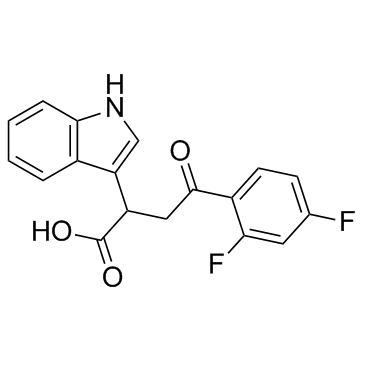Mitochonic acid 5
Modify Date: 2024-01-07 11:10:08

Mitochonic acid 5 structure
|
Common Name | Mitochonic acid 5 | ||
|---|---|---|---|---|
| CAS Number | 1354707-41-7 | Molecular Weight | 329.30 | |
| Density | N/A | Boiling Point | N/A | |
| Molecular Formula | C18H13F2NO3 | Melting Point | N/A | |
| MSDS | N/A | Flash Point | N/A | |
Use of Mitochonic acid 5Mitochonic acid 5 binds mitochondria and ameliorates renal tubular and cardiac myocyte damage. Mitochonic acid 5 modulates mitochondrial ATP synthesis. |
| Name | Mitochonic acid 5 |
|---|
| Description | Mitochonic acid 5 binds mitochondria and ameliorates renal tubular and cardiac myocyte damage. Mitochonic acid 5 modulates mitochondrial ATP synthesis. |
|---|---|
| Related Catalog | |
| Target |
Mitochondrial Metabolism[1] |
| In Vitro | Mitochonic acid 5 (MA-5) modulates mitochondrial ATP synthesis independently of oxidative phosphorylation and the electron transport chain. Mitochondrial dysfunction causes increased oxidative stress and depletion of ATP, which are involved in the etiology of a variety of renal diseases[1]. Mitochonic acid 5 (MA-5), which is derived from the plant growth hormone indole-3-acetic acid, can protect mitochondrial function by regulating energy metabolism and reducing mitochondrial oxidative stress. To observe the protective role of Mitochonic acid 5 in microglia under inflammatory conditions, TNFα is applied. Subsequently, the MTT assay is used to evaluate cell viability. In response to the TNFα treatment, cell viability significantly decreases. However, this effect is dose-dependently inhibited by Mitochonic acid 5 treatment[2]. |
| In Vivo | Administration of Mitochonic acid 5 (MA-5) to an ischemia-reperfusion injury model and a cisplatin-induced nephropathy model improved renal function. To examine the tissue-protective effect of Mitochonic acid 5, the oral bioavailability is examined. Oral administration of Mitochonic acid 5 increases the plasma concentration in a dose-response manner at the peak time of 1 hour[1]. |
| Cell Assay | The mouse BV-2 cells used in this study are cultured in L-DMEM supplemented with 10% fetal bovine serum (FBS) at 37°C in an atmosphere with 5% CO2. To induce inflammatory injury, cells are treated with 10 ng/mL TNFα for about 12 h. Mitochonic acid 5 (0-10 μM) is incubated with BV-2 cells for about 12 h with TNFα treatment[2]. |
| Animal Admin | Mice[1] For evaluation of the blood concentrations of Mitochonic acid 5 (MA-5), Mitochonic acid 5 is orally administered at doses of 25, 50, or 150 mg/kg to C57/BL 6 mice, and blood samples are collected at the designated times. After 1 hour, the mice are euthanized. The blood concentration of Mitochonic acid 5 is determined by LC/MS/MS[1]. |
| References |
| Molecular Formula | C18H13F2NO3 |
|---|---|
| Molecular Weight | 329.30 |
| Storage condition | 2-8℃ |